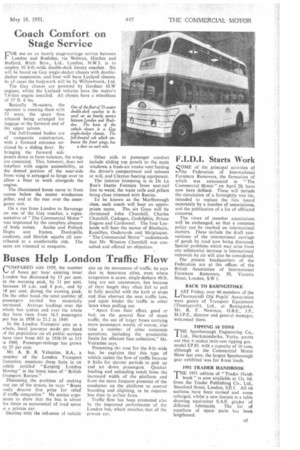Buses Help London Traffic Flow
Page 39

If you've noticed an error in this article please click here to report it so we can fix it.
CO7vIPARED with 1939, the number of buses per hour entering inner London has decreased by 15 per cent. in the morning peak, by 11 per cent. between 10 a.m. and 4 p.m., and by 18 per cent, during the evening peak. On the other hand, the total number of passengers carried has materially increased. Average loadings over the whole bus system and over the whole day have risen from 16.3 passengers per bus in 1938 to 21.2 in 1949.
In the London Transport area as a whole, local journeys made per head af thc popidation on all public services have risen from 443 in 1938-39 to 513 tn 1949. Passenger-mileage has grown by 25 per cent.
Mr. A. B. R. Valentine, B.A., a nember of the London Transport Executive, mentions these facts in an wade entitled "Keeping *London Moving" in the latest issue of " British fransport Review."
Discussing the problem of making 'est use of the streets, be says: " Buses eisily deserve first prize for relief )f traffic congestion." He quotes argunents to show that the bus is about lye times as economical of road space is a private car.
Dealing with the influence of vehicle
size on the movement of traffic, he says that in American cities, even where congestion is acute, single-deckers 40-fe long are not uncommon, but because of their length they often fail to pull in fully parallel with the kerb at stops and thus obstruct the next traffic lane, and again hinder the traffic in other lanes when pulling out.
"Apart from their effect, good or bad, on the general flow of street traffic, the use of larger buses carrying more passengers would, of course, also raise a numbee of other economic questions, including the practicable limits for efficient fare collection," Mr. Valentine says.
Presenting the case for the 8-ft.-wide bus, he • explains that this type of vehicle assists the flow of traffic because it halts for shorter periods to pick up and set down passengers. Quicker loading and unloading result from the increased width of the platform and from the more frequent presence of the conductor on the platform to control boarding and alighting, as he requires less time to collect fares.
Traffic flow has been promoted also by the improved performance of the London bus, which matches that of the private car.




























































































